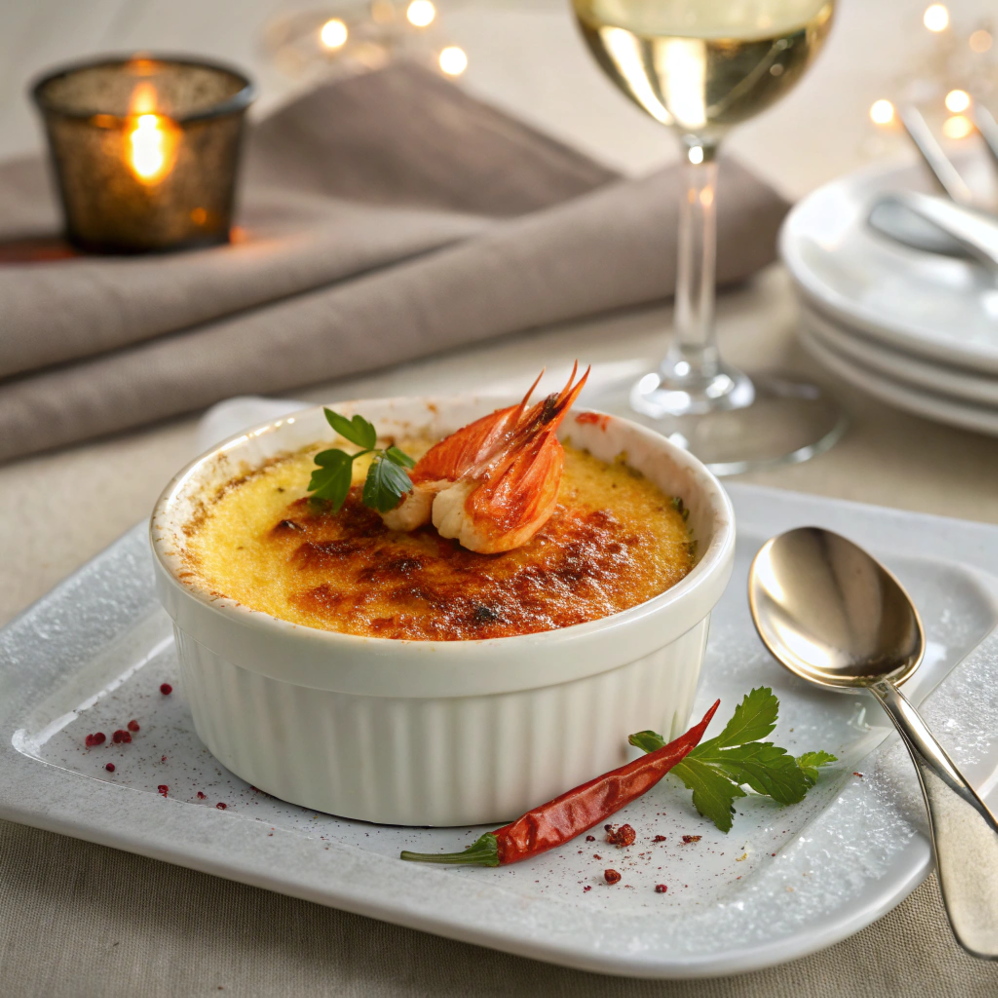
Table of Contents
When it comes to decadent appetizers and show-stopping culinary creations, few dishes can rival the creamy, indulgent perfection of a Crab Brulee Recipe. Picture this: sweet, succulent crab meat suspended in a velvety custard, topped with a golden caramelized crust that crackles under your spoon. It is the perfect marriage of savory and sweet, and it has the power to captivate guests at a holiday dinner, a romantic date night, or any gathering where you want to impress.
In this in-depth guide—written by a seasoned food blogger with over 40 years of experience in creating and refining recipes—we will explore everything there is to know about making the perfect Crab Brulee Recipe. From selecting the freshest crab meat and the right type of cream, to mastering the art of caramelizing sugar on top, you will be walked through each step meticulously. Think of this as your definitive resource for the best way to transform humble crab into an elegant, restaurant-quality dish.
Savory brulees, traditionally associated with desserts like crème brûlée, have gained popularity as culinary boundaries expand. This guide will teach you to prepare a delicious Crab Brulee while providing insights on variations, pairing suggestions, equipment choices, and troubleshooting tips to ensure a perfect dish every time. Master the techniques here to confidently elevate crab for your next special occasion.
The Allure of Crab Brulee
One of the biggest draws is the Contrast of Textures. Velvety custard envelops sweet crab, crowned by a crackly caramelized layer that shatters with each tap.
Next, its Visual and Gourmet Appeal is undeniable. Glossy, golden-topped ramekins instantly evoke fine dining and captivate guests before the first bite.
Finally, it’s a Versatile Dish suited to any occasion. Serve crab brulee as a refined appetizer or scale up for a decadent main—every spoonful impresses.
Ingredients and Kitchen Tools
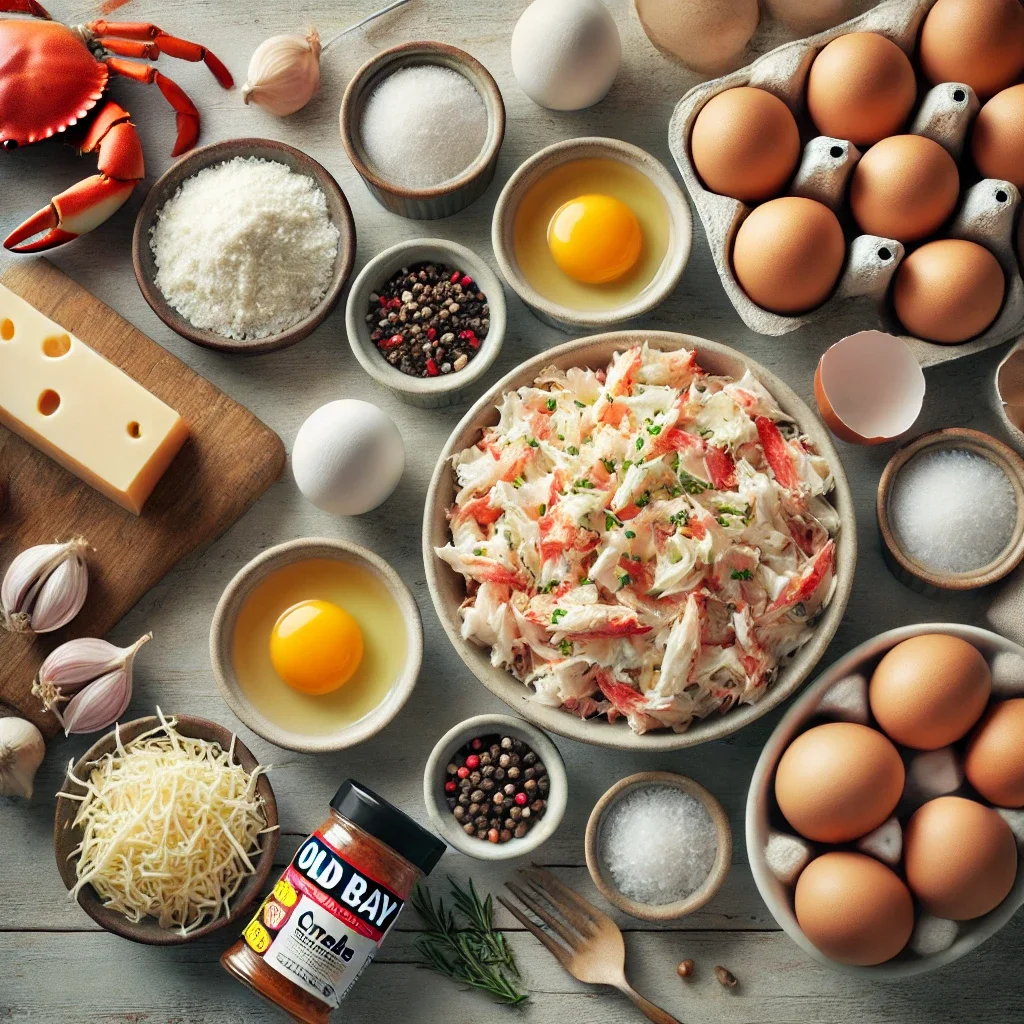
Before you begin assembling your Crab Brulee Recipe, it is essential to gather all the ingredients and tools you will need. Proper mise en place (the practice of organizing and arranging all ingredients before cooking) is crucial for an efficient and enjoyable cooking experience.
Core Ingredients
- Fresh Crab Meat (8–12 ounces, depending on how crab-forward you want your dish): Look for fresh, high-quality crab meat. Lump crabmeat or jumbo lump is often preferred for its texture and sweetness.
- Heavy Cream (1–2 cups): The foundation of the custard. Heavy cream adds the necessary richness and body to your brulee.
- Eggs (3–4 large eggs): Essential for setting the custard. Some recipes also call for additional egg yolks for extra creaminess.
- Cheese (Optional): A small amount of grated cheese like Gruyère, Parmesan, or Fontina can deepen the savory profile. This is optional but often recommended if you like a slightly richer flavor.
- Seasonings: Salt, pepper, a pinch of nutmeg (optional), Old Bay seasoning (common for seafood), minced garlic, or chopped shallots.
- Sugar or Seasoned Breadcrumb Topping: While classic dessert crème brûlée uses sugar for the crust, a savory twist might employ sugar or a mix of breadcrumbs and cheese. You can also use a small amount of raw sugar to create a lightly sweet crust that complements the crab’s natural sweetness.
Additional Flavor Boosters
- Seafood Stock: A splash can add depth if you want an intense seafood essence.
- Lemon Zest: Offers a bright, citrusy counterpoint.
- Herbs: Fresh tarragon, chives, or dill go beautifully with crab.
- White Wine: A tablespoon or two reduces nicely, pairing well with cream and crab.
- Paprika or Cayenne: A subtle kick of heat can accentuate flavors.
Kitchen Tools
- Ramekins: Individual baking dishes are classic for brulees. Choose 4–6 ounce ramekins for appetizers or smaller servings.
- Mixing Bowls: You will need separate bowls for whisking eggs and preparing the custard mixture.
- Whisk: Essential for blending the custard smoothly.
- Baking Pan or Water Bath (Bain-Marie): A larger pan to hold the ramekins, plus hot water for even baking.
- Kitchen Torch or Broiler: Needed to caramelize the top. A kitchen torch offers more control, but a broiler can do the job in a pinch.
- Measuring Cups and Spoons: For precise measurements.
- Fine-Mesh Strainer (Optional): Some chefs like to strain the custard mixture for maximum smoothness.
With these ingredients and tools at your disposal, you are already halfway to creating an unforgettable Crab Brulee Recipe experience. Properly sourced crab and fresh dairy will ensure the best results, so do not skimp on quality
Choosing and Preparing Your Crab
The single most influential factor in a Crab Brulee Recipe is the quality of the crab. Selecting and preparing your crab carefully will set the tone for the entire dish.
Types of Crab Meat
- Jumbo Lump: Premium large pieces prized for sweet flavor and appealing appearance.
- Backfin or Lump: Slightly smaller fragments but still good flavor.
- Claw Meat: Darker meat, stronger flavor; can be mixed with lump for depth.
- Imitation Crab (Surimi): Typically not recommended for a high-end dish like a brulee, but if budget constraints are in play, it can be used in a pinch. However, you will lose out on some authentic crab sweetness.
Fresh vs. Canned
- Fresh Crab: Typically yields the best flavor and texture. This could be refrigerated, pasteurized crabmeat, or fresh-cooked crab you pick yourself.
- Canned Crab: While more economical and convenient, it can taste bland or watery. If you must use canned, drain thoroughly and pat dry with paper towels to remove excess liquid.
Prepping the Crab
- Inspect for Shell Fragments: Even well-processed crab can contain small shards of shell or cartilage. Gently pick through the meat by hand.
- Drain Excess Liquid: Whether fresh or canned, crab can hold moisture. Pat it dry to prevent the custard from becoming runny.
- Season Lightly: Some cooks like to toss the crab meat with a pinch of salt, pepper, or Old Bay seasoning before adding it to the custard mixture.
Remember, the ultimate goal is to highlight the natural, briny sweetness of the crab. Whether you splurge on jumbo lump or opt for standard lump, the key is freshness and careful preparation. By treating your crab with respect, your Crab Brulee Recipe will sing with flavor and elegance.
Preparing the Custard Base
A luxurious custard is at the heart of every Crab Brulee Recipe. If the custard is too thin, your dish might turn watery. If it is too thick, the crab could be overwhelmed. Achieving that perfect balance is a straightforward process but demands attention to detail.
Custard 101
A savory custard generally follows the same principle as a sweet one: a mixture of eggs (or egg yolks) and cream, seasoned and baked gently until set. For the Crab Brulee Recipe, the ratio is critical:
- Eggs to Cream Ratio: Typically 1 egg to ¼ cup (60 ml) of cream, though this can vary based on personal preference. This ratio ensures a delicate set without becoming rubbery.
Step-by-Step Custard Preparation
- Crack the Eggs: Depending on the number of servings and richness desired, you will need 3–4 eggs. If you prefer a silkier texture, substitute 1 or 2 whole eggs with 2 egg yolks.
- Whisk Thoroughly: In a mixing bowl, whisk the eggs with a pinch of salt, black pepper, and any desired dry spices (paprika, Old Bay, etc.).
- Incorporate Cream: Slowly pour in the heavy cream while whisking constantly. This helps create a homogenous mixture.
- Taste Test: Yes, you can carefully taste the raw custard for seasoning. If needed, adjust salt, pepper, or other spices.
- Optional Straining: For an ultra-smooth texture, run the custard through a fine-mesh strainer. While not mandatory, it removes any egg chalaza or lumps.
Enhancing the Flavor Profile
- Cheese: If adding cheese like Gruyère, whisk a small amount into the custard or fold it in gently with the crab.
- Herbs: Chop fresh herbs like chives, tarragon, or parsley and stir them into the custard.
- Aromatics: Sautéed shallots or minced garlic can elevate the savory notes.
Why This Matters
The custard sets the stage for your crab. You want it rich enough to complement the crab’s sweetness, but not so heavy that it feels cloying. By understanding the ratio, texture, and flavor enhancers, your Crab Brulee Recipe will be poised for success.
Combining Crab and Custard
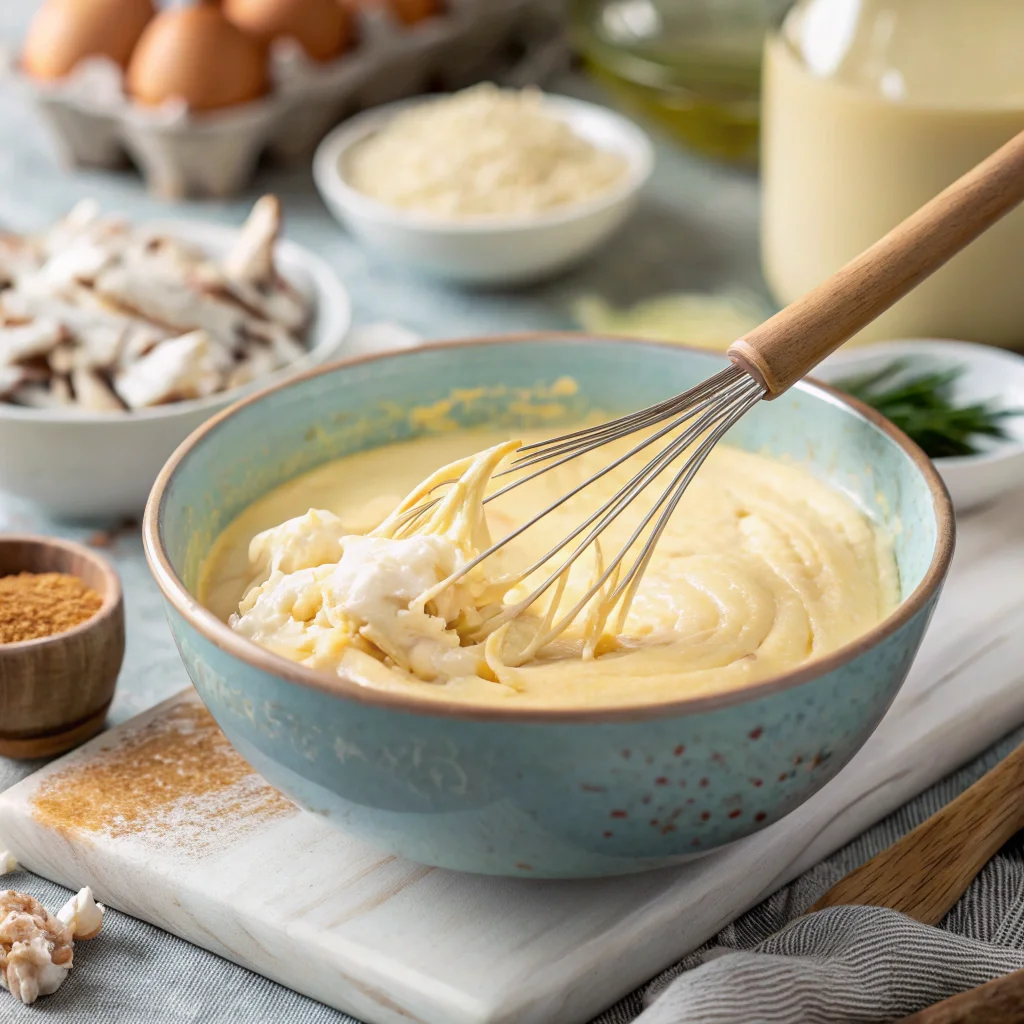
Having prepared your crab and custard components separately, the next step in the Crab Brulee Recipe is bringing them together. This step, although simple, can determine whether your final dish has a balanced distribution of crab throughout or if it sinks to the bottom.
Best Practices for Folding
- Gentle Folding: When mixing fresh crab meat into the custard, do so gently. The goal is to keep the delicate lumps of crab intact as much as possible.
- Season as You Go: Add a sprinkle of salt and pepper if the custard needs more seasoning after the crab is introduced. Over-seasoning can be easily done if you are not careful, so taste regularly.
- Balance: Aim for a mixture that is roughly half custard, half crab. This will give you a bite of crab in every spoonful without overwhelming the velvety base.
Consistency Check
- If the custard seems overly thick, add a splash of cream or seafood stock.
- If it is too runny, consider adding an extra egg yolk or a bit more cheese to help the mixture set during baking.
Ramekin Filling
Carefully ladle or pour the crab custard mixture into your prepared ramekins. Leave about ¼ inch of space at the top, as the custard can puff slightly as it bakes. Overfilling can cause spills or uneven cooking.
The synergy between crab and custard is delicate and elegant. By taking these extra steps and being mindful of your mixture, your Crab Brulee Recipe will retain a luxurious mouthfeel and offer bursts of fresh crab flavor in every mouthful.
Step-by-Step Cooking Instructions
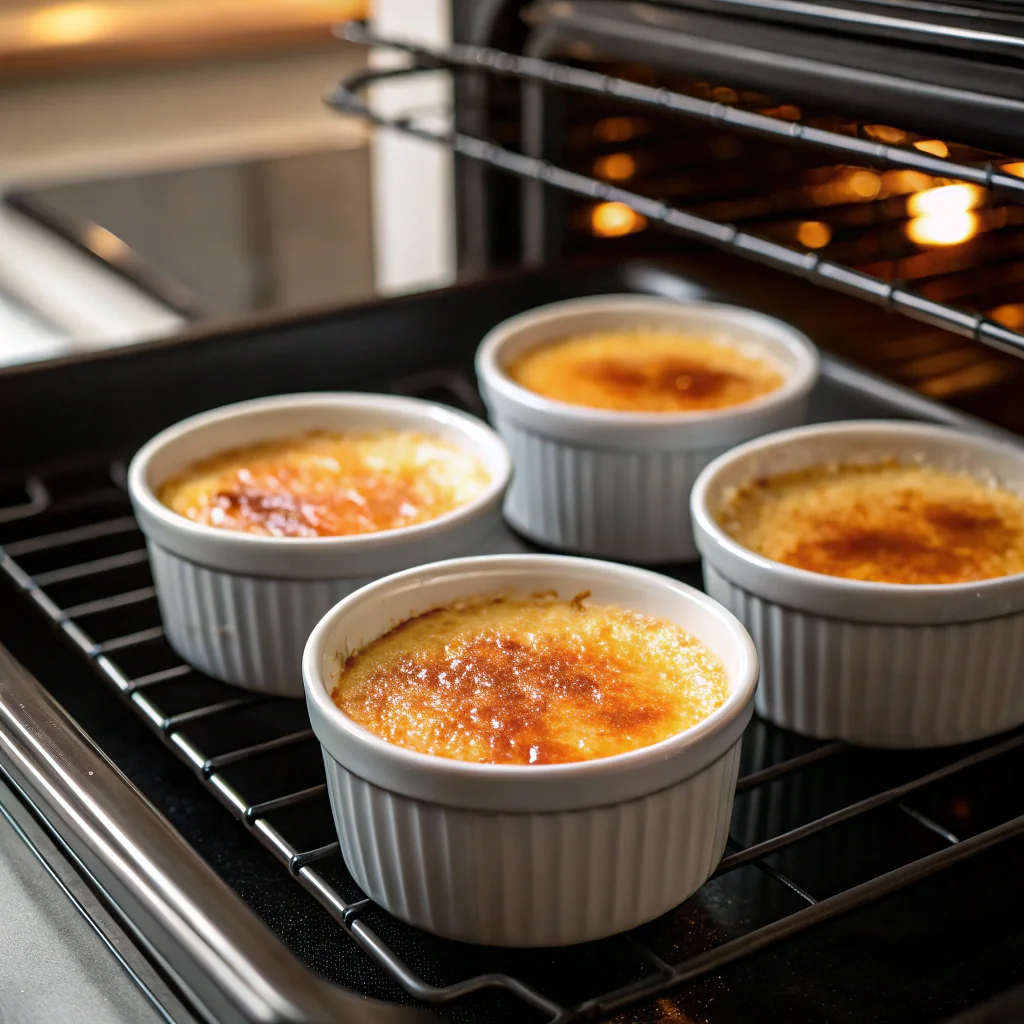
This section provides a detailed roadmap for successfully executing your Crab Brulee Recipe. Follow these steps carefully to ensure that every component—from the custard to the caramelized top—turns out perfectly.
1.Preheat Your Oven
• Set your oven to 325°F (160°C). A moderate temperature ensures a slow, even bake, crucial for setting the custard without curdling or developing a grainy texture.
2.Prepare the Water Bath (Bain-Marie)
• Choose a large baking dish or roasting pan that can accommodate all your ramekins without crowding.
• Place a clean kitchen towel at the bottom of the pan to prevent the ramekins from sliding. This also helps distribute heat evenly.
• Set the filled ramekins on the towel inside the pan.
3.Fill with Hot Water
• Heat water in a kettle or saucepan. Once it is near boiling, carefully pour it into the baking dish.
• The water level should reach about halfway up the sides of the ramekins. This water bath ensures a gentle, consistent heat that leads to a silky custard.
4.Bake Until Set
• Baking Time: Typically 30–40 minutes, depending on the size of your ramekins and the ratio of eggs to cream.
• Check Doneness: The custard should be mostly set but still slightly jiggly in the center when you tap the ramekin. It will continue to cook and firm up after you remove it from the oven.
5.Cool Down
• Using oven mitts or tongs, carefully remove the ramekins from the water bath.
• Let them cool on a wire rack for about 15–20 minutes. You can serve them warm or refrigerate for a cooler, firmer texture.
6.Brulee Topping Basics
• Sugar Topping: If going for a sweet-salty finish, sprinkle a thin, even layer of sugar (white, turbinado, or raw sugar) over the top of each custard.
• Breadcrumb or Cheese Topping: For a purely savory approach, you can mix breadcrumbs with grated cheese (e.g., Parmesan) and sprinkle that instead.
After following these steps, you have a nearly finished Crab Brulee Recipe—all that remains is to torch or broil the surface, creating the signature crackly top that sets this dish apart.
Torching and Caramelizing the Top
No Crab Brulee Recipe is complete without that iconic brulee surface. Whether you opt for a sweet caramelized sugar crust or a savory toasted breadcrumb top, this final stage transforms a simple custard into a dish worthy of fine dining.
Using a Kitchen Torch
- Sprinkle Topping: Add your chosen topping—sugar, breadcrumbs, or cheese—onto the cooled custard.
- Adjust the Flame: If your torch has an adjustable flame, opt for medium to medium-high heat.
- Smooth, Circular Motions: Move the torch in small circles, about 2–3 inches from the surface. Do not hold the flame in one spot too long to avoid burning.
- Look for Caramelization: The sugar will melt and bubble, forming a golden-brown crust. If using breadcrumbs or cheese, watch for browning without scorching.
Using the Broiler
- Preheat Broiler: Position your oven rack a few inches from the heating element.
- Monitor Closely: Place the ramekins under the broiler, keeping an eye on them. Sugar, breadcrumbs, or cheese can burn quickly.
- Remove Once Golden: The crust can go from perfect to burned in seconds, so be vigilant.
Balancing Sweet vs. Savory
- A sweet-salty crust can heighten the natural sweetness of crab.
- A purely savory crust (breadcrumb-cheese mix) provides an earthy, toasty note that complements the briny flavor of crab.
The key is control and observation. The right brulee top should crack gently when tapped with a spoon or fork, revealing the creamy custard and succulent crab beneath.
Flavor Variations and Enhancements
One of the beauties of a Crab Brulee Recipe is its versatility. While the classic rendition is undeniably delicious, you can customize it to suit your personal tastes or to reflect seasonal ingredients.
Herbs and Spices
- Tarragon: Offers a subtle anise note that blends perfectly with seafood.
- Chives or Green Onions: Add a fresh, oniony bite.
- Cajun or Creole Seasoning: Provides a robust, spicy kick for those who crave heat.
Additional Seafood Twists
- Shrimp: Add a small portion of chopped shrimp to accentuate the briny profile.
- Lobster: Replace half of the crab with lobster tail for a truly indulgent brulee.
- Smoked Salmon: Sprinkle flakes of smoked salmon on top for a smoky contrast.
Cheese Variations
- Goat Cheese: Lends tanginess and creaminess.
- Fontina: Mild, melts smoothly, adds subtle nuttiness.
- Parmesan Crust: For a distinctively sharp topping that forms a crisp layer under the broiler or torch.
Aromatic Infusions
- Truffle Oil: A few drops can turn your Crab Brulee into a luxurious experience.
- Roasted Garlic: Mash roasted garlic cloves into the custard for a sweeter, richer garlic flavor.
- Shallots: Sauté chopped shallots in butter and fold them into the custard for complexity.
Feel free to experiment—start small with your additions so as not to overpower the crab. The essence of the Crab Brulee Recipe is balance, so any enhancement should complement rather than overshadow the primary ingredient.
Serving Suggestions and Pairings
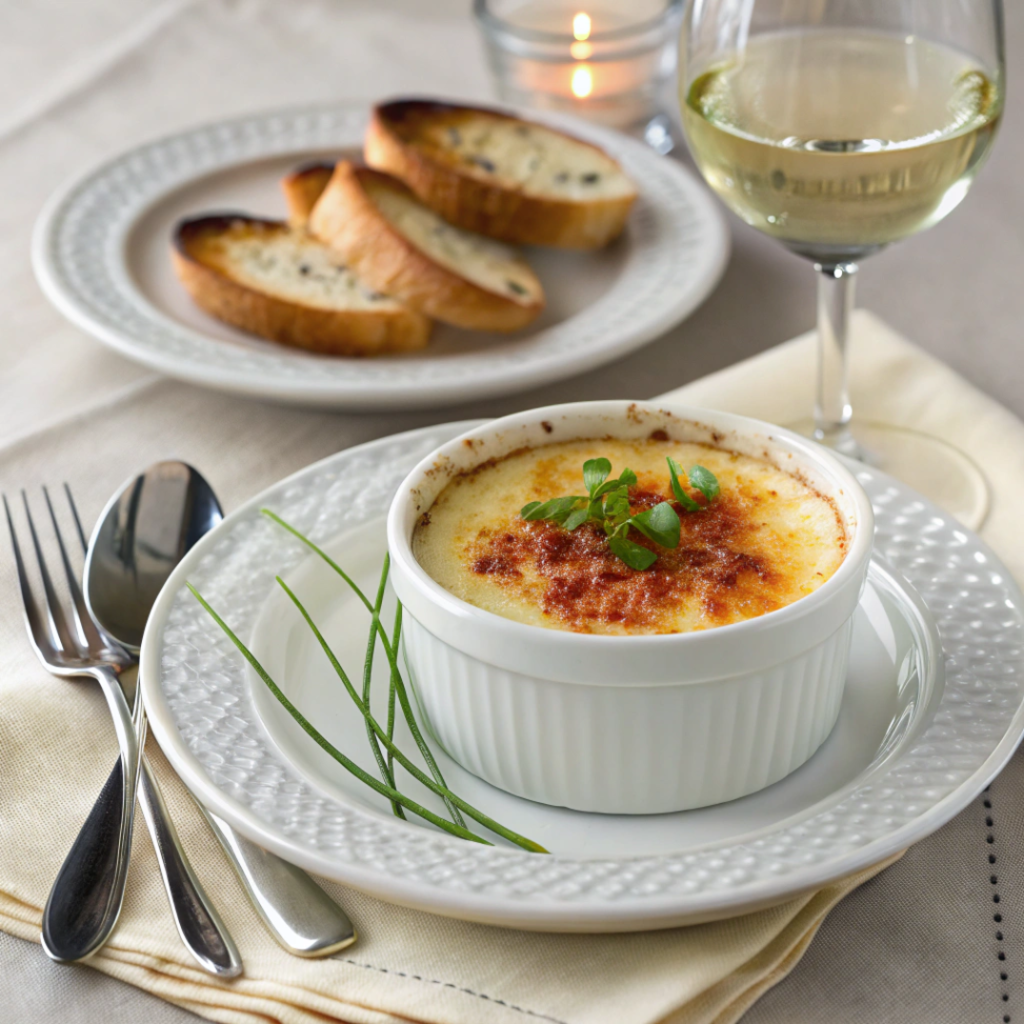
Part of the sophistication of a Crab Brulee Recipe lies not only in its taste and texture but also in how you present and pair it with other elements of the meal.
Presentation
- Individual Ramekins: A classic, upscale look. Serve each guest their own brulee for a personalized touch.
- Color Contrast: Garnish with fresh herbs like chives or dill. A bright green garnish on the golden crust adds visual appeal.
- Accompaniments: Warm crusty bread or crispy crostini is perfect for dipping into the creamy custard.
- Wine and Beverage Pairings
- White Wine: Chardonnay or a crisp Sauvignon Blanc complements the richness of the crab custard.
- Sparkling Wine: A dry Champagne or Prosecco cuts through the creaminess with bright acidity.
- Light Beer: For a more casual setting, a refreshing lager or Pilsner can work surprisingly well.
Complementary Dishes
- Green Salad: A simple salad with a vinaigrette dressing balances out the richness of the brulee.
- Roasted Vegetables: Asparagus, zucchini, or mushrooms bring earthiness and texture.
- Seafood Platter: Combine with shrimp cocktail or a lobster tail for a decadent seafood feast.
By carefully selecting sides and drinks that underscore the dish’s savory-sweet notes, you round out the dining experience. The result is a cohesive meal that highlights the star of the show: your Crab Brulee Recipe.
Even the most well-planned Crab Brulee Recipe can encounter challenges. Here are common pitfalls and ways to address them:
Why Did My Custard Turn Grainy?
Overcooking: Baking at too high a temperature or leaving it too long in the oven can cause eggs to curdle.
Solution: Lower the oven temperature to 300–325°F (150–160°C) and keep an eye on the custard’s set.
My Crab Sank to the Bottom. What Should I Do?
Distribution Issues: If the custard is too thin or you did not fold the crab gently, it might settle.
Solution: Consider gently stirring the crab once halfway through baking or add a bit more egg yolk for extra viscosity.
Can I Make the Crab Brulee Ahead?
Yes: You can prepare the custard mixture a day ahead and keep it refrigerated. Bake it on the day of serving. Alternatively, you can bake it, refrigerate, and then torch the topping just before serving.
Is the Sugar Topping Necessary for a Savory Dish?
Personal Preference: Many enjoy a light sugar crust for the sweet-salty combination. If you prefer a fully savory profile, use breadcrumbs and cheese instead.
My Brulee Is Too Thick or Too Rich. How Can I Lighten It?
-Adjust Cream Ratio: Substitute part of the heavy cream with half-and-half or whole milk.
Add Vegetables: Incorporate finely chopped spinach, leeks, or bell peppers to add bulk and lighten the overall richness.
Quick Tips
- Always Taste as You Go: Adjust seasoning before the custard goes into the ramekins.
- Use Room-Temperature Ingredients: Eggs, cream, and crab at room temperature blend more easily and reduce cooking time.
- Practice Makes Perfect: Every oven and every brand of cream can vary, so do not get discouraged if your first attempt needs tweaking.
Crafting the perfect Crab Brulee Recipe is both an art and a science. It requires attention to detail, high-quality crab, and a willingness to experiment with flavors. Here is a concise rundown of the key points from this 40-year veteran’s perspective:
- Ingredient Quality: Start with the best crab you can find—fresh, sweet, and minimally processed.
- Custard Ratio: Achieve a delicate balance between eggs and cream. Consider adding cheese, herbs, or light aromatics to intensify flavor.
- Even Baking: A water bath (bain-marie) ensures gentle, consistent heat. Aim for a custard that is set but still slightly jiggly.
- Crackly Top: Whether using sugar, breadcrumbs, or cheese, caramelizing the top with a torch or broiler is essential to achieve that signature crust.
- Flavor Variations: Do not be afraid to experiment with herbs, spices, or even other seafood. Just remember that crab should remain the star.
- Serving and Pairing: Present your brulee in individual ramekins, garnish with fresh herbs, and pair with complementary wines or sides for a truly memorable meal.
- Troubleshooting: Know how to adjust if the custard curdles, the crab sinks, or the topping burns. Small tweaks can rescue a recipe from near-disaster.
Having walked through each stage—from selecting your crab to torching the final crust—you should now have the confidence to replicate this Crab Brulee Recipe in your own kitchen. Whether you stick to the classic approach or explore creative variations, the fundamentals remain the same: quality ingredients, patient technique, and a keen palate.
The result? A restaurant-worthy dish that marries the sweet essence of crab with the velvety richness of a savory custard. It is a testament to the endless possibilities in the culinary world when tradition meets innovation. So go ahead—break out those ramekins, fire up the kitchen torch, and indulge in one of the most exquisite seafood creations out there. Your dinner guests (and your own taste buds) will thank you.
You have just completed reading an in-depth guide on how to elevate your Crab Brulee Recipe to new heights. By emphasizing freshness, technique, and a bit of culinary curiosity, you can turn a simple concept into an unforgettable dining experience. Each step of this Crab Brulee Recipe process—from ingredient selection to presentation—contributes to the final masterpiece that is sure to dazzle at your next gathering.
Crab Brulee Recipe
Course: Recipes4
servings20
minutes40
minutes505
kcalWhether you are serving an elegant dinner party or indulging at home, this Crab Brulee Recipe stands out for its creamy custard and the delicate sweetness of fresh crab. By following these straightforward steps, you will achieve a sophisticated, restaurant-quality dish that highlights the best of land and sea in every spoonful.
Ingredients
- Fresh Crab Meat (8–12 oz.)
Jumbo lump or lump recommended for the best Crab Brulee Recipe texture.
- Heavy Cream (1½ cups)
Essential for a rich, velvety custard in your Crab Brulee Recipe.
- Eggs (3 large or 2 large + 2 yolks)
Helps create the perfect savory custard base.
- Optional Cheese (½ cup, grated)
Gruyère, Parmesan, or Fontina can enhance the overall flavor of your Crab Brulee Recipe.
- Seasonings
Salt and freshly ground black pepper to taste
Pinch of Old Bay seasoning (optional)
A dash of paprika or cayenne for subtle heat
- Sugar or Breadcrumb Topping
Choose sugar for a sweet-salty finish or savory breadcrumbs/Parmesan for a toasted crust in your Crab Brulee Recipe.
- Optional Add-Ins
Minced garlic, shallots, fresh herbs (chives, tarragon), lemon zest, or a splash of white wine.
Directions
- Preheat the Oven
- Set oven to 325°F (160°C). This moderate temperature ensures your Crab Brulee Recipe custard bakes gently.
- Prepare Custard Base
- In a bowl, whisk together eggs, salt, pepper, and Old Bay (if using).
- Gradually add the heavy cream, continuing to whisk. Adjust seasonings.
- Strain through a fine-mesh sieve if you want an ultra-smooth Crab Brulee Recipe custard.
- Combine Crab and Custard
- Gently fold the fresh crab meat into the custard. Be careful not to break up the crab lumps too much—this keeps the Crab Brulee Recipe rich with crab flavor in each bite.
- Fill Ramekins
- Place ramekins in a large baking dish lined with a kitchen towel (for stability).
- Pour the custard mixture into each ramekin, leaving about ¼ inch of space at the top.
- Set Up the Water Bath
- Carefully pour hot water into the baking dish until it reaches halfway up the sides of the ramekins. This bain-marie technique helps your Crab Brulee Recipe bake evenly.
- Bake
- Bake for 30–40 minutes, or until the custard is mostly set but still has a slight jiggle in the center.
- Remove ramekins from the water bath and let them cool for about 15–20 minutes on a wire rack.
- Top and Caramelize
- Sprinkle each custard with either sugar (for a classic sweet-meets-savory Crab Brulee Recipe finish) or a mix of breadcrumbs and cheese.
- Use a kitchen torch to caramelize the topping, or place ramekins under the broiler until the crust is golden brown.
- Serve and Enjoy
- Let the caramelized top set for a minute or two. Serve the Crab Brulee Recipe warm alongside crusty bread or fresh greens. A chilled white wine like Sauvignon Blanc complements it beautifully.
Notes
- This recipe card is designed to give you the essential instructions and ingredient measurements for your Crab Brulee Recipe at a glance. For an even more detailed tutorial, refer to the comprehensive word guide on perfecting every aspect of this decadent seafood delight.
